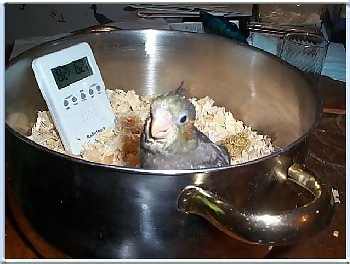
So You have a new baby and you are not sure if it is a male or a female? Or maybe you have an older fid that has you a bit perplexed. This page will hopefully help you to determine what sex your baby is with a few helpful tips in determining factors. There are some determining factors between the genders; these would be physical differences although the most obvious are not always visible until the fid has already gone through their first molting, there are personality traits which are distinctly different and some can become noticeable as early as 12 weeks old; although as a breeder I have now come to notice distincting factors as early as 3 weeks old, there is the wing sexing method and of course the 100 percent DNA testing that can be done. The DNA testing may be considered unfeasible to one unless they are a breeder and the sex is an important factor to them for breeding purposes. I will show some ways one can help to determine without DNA testing if their fid is a boy or a girl.
There are physical factors which in some cases are very distinctive between
the male and the female cockatiel and with some mutations it becomes very obvious as to the gender of the fid by their physical appearance due to color differences; however these physical attributes are not apparrent for babies under 6 months of age. For those of you who have a baby who is 6-8 months old and have went through their first molt already you could check out my mutation page where I offer pics of both genders where possible; or at least description differences between the males and females. Just visit the below link
What Mutation Is My Cockatiel?
When I have babies I can sometimes sex my babies right from the nest based on
genetic factors; for example if the hen is Normal and the male is Normal and
I have a baby Lutino which is hatched with red eyes I know for sure without a
doubt this baby is a female because the female can not pass this gene down
but the male can. But in order to have a male lutino both parents must carry
the gene, and female can not be split to lutino therefor she must be visual lutino.
There are times though with many mutations and pairs the genetic
sexing is not possible so I use a method referred to as wing dot sexing. This method
is not always 100 percent but overall I do find it usually very accurate.
I have posted some pics below for you to view the differences between a male and
a female wing dots for both babies and adults. If you wish to view a larger image
of a particular picture then just click on it.
Wing Dot Sexing Method
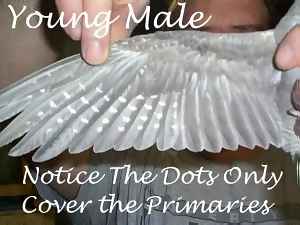
| 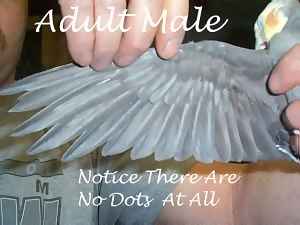
|
|
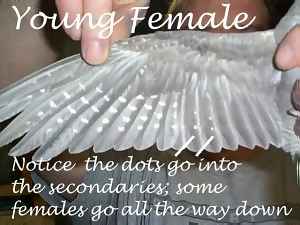
| 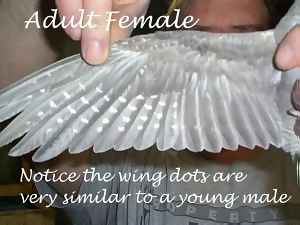
|
Both males and females have their own little special traits making both of them precious fids to have. My females make me laugh when they try new tricks on their swings and my males when they want to but are too afraid too..:).Both are loving, loyal and affectionate and make wonderful pets.